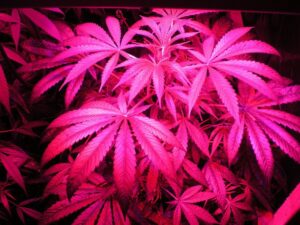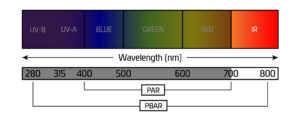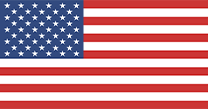
December 19, 2023
Harnessing the Power of Red and Far-Red Light in Cannabis Cultivation
In the ever-evolving landscape of cannabis cultivation, the role of light takes center stage. Red and far-red light, with their distinct wavelengths, are emerging as application tools wielded by growers to optimize plant growth and maximize yields.
Previously, we described the recent findings of far-red light on plant growth rates and characteristics, research made possible only by the advent of efficient far-red LEDs [1]. In this article, we uncover the practical impact of these light wavelengths in the world of cannabis cultivation, exploring the science behind them and how cultivators can strategically use them to their advantage.
The Effects of Red and Far-Red Light in Cannabis

Red and far-red light play pivotal roles in shaping the growth and development of cannabis plants. Photoreceptors, particularly phytochromes, are attuned to these wavelengths, influencing various physiological processes. Red light, ranging from 600 to 700 nm, accelerates root and flowering growth, promotes deep stem development, and enhances the production of THC and terpenes. On the other hand, far-red light, ranging from 700 to 750 nm, influences plant tolerance to stress, including low temperatures and high salinity. It also plays a crucial role in flowering and can be utilized to manipulate plant responses for increased yields [2].
Practical Applications: Maximizing Growth and Yield
Growers can leverage the unique characteristics of red and far-red light to create an optimal environment for cannabis cultivation. During the flowering period, bathing plants in red light can lead to larger and more potent buds. Simultaneously, incorporating far-red light can enhance stress resilience, accelerate flowering, and manipulate plant responses for increased yield. The strategic use of these wavelengths is particularly valuable for indoor cultivation setups where environmental control is paramount.
Implementing Red and Far-Red Light in Cultivation Practices

One example of utilizing the effects of far-red would be to use a spectrum that has an increased far-red to red ratio to induce a shade avoidance response. Since this introduces stretching (unless enough blue is present; see link to previous article), this treatment is not recommended for the vegetative stage, but it would boost leaf area and radiation capture in the seedling stage. Additionally, it has been shown that increased far-red promotes flowering. Applying the right amount of far-red during the flowering stage can help create robust, resinous flowers over a shorter time period and propel these plants to where you want or need them to be [3].
Defining and Measuring PAR and Far-Red Light

Utilizing far-red light has led to new scientific discoveries and debates regarding its accurate measurement and reporting in terms of PAR, Photosynthetic Active Radiation. In a recent paper, researchers argue that because far-red has been shown to participate in photosynthesis, it should be included in PAR. [4] Jumplights is using the term PBAR which stands for Photobiologically Active Radiation [5].
The other component of this is the accurate measurement of far-red. PAR meters each have their own sensitivities and biases when it comes to measuring photon intensity across a range of wavelengths. Any reputable brand should provide this information so that you know which wavelengths may or may not be measured. For this reason, incorporating far-red and then determining its presence can be challenging, and growers should be aware that their meter might not be picking it up with the same strength as other photons. For questions or recommendations about this, please contact your JumpLights expert; they are well-versed in all things photometric.
Conclusion
As cannabis cultivation progresses, our comprehension of the intricate relationship between light and plant physiology deepens. Red and far-red light, once portions of the spectrum that could not be isolated in complex plant experiments, have now emerged as powerful tools for growers aiming to optimize the potential of their crops. This transcends mere wavelengths; it involves navigating a spectrum of possibilities where practical knowledge converges with innovation. The deliberate management of the combination of red and far-red light provides cannabis growers with a dynamic toolset to sculpt plant morphology and enhance overall productivity.
References
[1] JumpLights: The Significance and Often Overlooked Impact of Far-Red Photons on Plant Growth
[2] Professor DeBacco, “Overview of Far Reds Impact on Cannabis Production” 5/14/2021. [Video]. https://youtu.be/sS7aAcacfgk?si=3y0JuFpJroP7muqG https://www.youtube.com/watch?v=5YsovYvRFUY&t=690s&ab_channel=DeBaccoUniversity
[3] Gianmaria Magagninia, Gianpaolo Grassia & Stiina Kotirantab, “The Effect of Light Spectrum on the Morphology and Cannabinoid Content of Cannabis sativa L.” Med Cannabis Cannabinoids 2018;1:19–27.
[4] Shuyang Zhen, Marc van Iersel & Bruce Bugbee, “Why Far-Red Photons Should Be Included in the Definition of Photosynthetic Photons and the Measurement of Horticultural Fixture Efficacy.” Front. Plant Sci., 22 June 2021
[5] LedMagazine ASABE publishes a metric standard for LED-based horticultural lighting
Sec. Crop and Product Physiology




